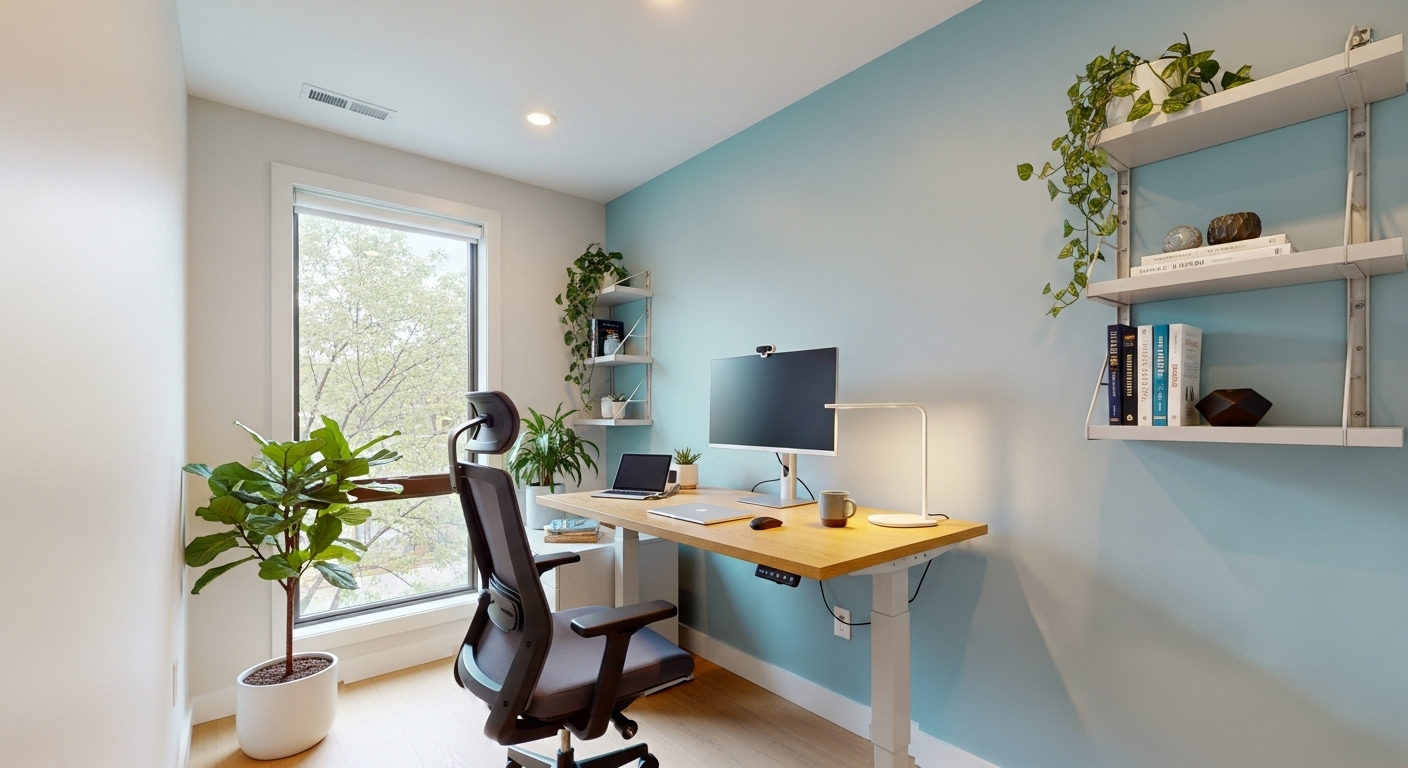The vibrant, pulsating energy of a coworking space is both its greatest asset and its most significant challenge. For the modern professional, the promise of community, networking, and a dynamic atmosphere can quickly be overshadowed by a torrent of distractions that derail deep, meaningful work. This is particularly true in a city known for its relentless creative and technological hum. The key to thriving is not to isolate yourself, but to architect a system for intentionality. This post introduces the Berlin Focus Protocol, a strategic framework designed to help you harness the collaborative energy of a shared workspace without sacrificing personal productivity. It’s a structured approach that moves beyond simple tips like “wear headphones” and delves into the pre-work rituals, environmental curation, and boundary-setting tactics necessary to achieve peak performance. By adopting this protocol, you can transform your coworking experience from a source of random interruptions into a powerful engine for focused output and professional growth.
The Pre-Work Ritual: Setting Your Intention Before You Arrive
The battle for productivity is often won or lost before you even step foot into your coworking space. Arriving without a clear plan is like setting sail in a storm without a compass; you’ll be tossed about by the demands and distractions of others. A robust pre-work ritual is your anchor. This process begins the night before or first thing in the morning. Start by identifying your top 1-3 Most Important Tasks (MITs) for the day. These are the needle-moving activities that, if completed, will make the day a success regardless of what else happens. Write them down on a physical notepad or in a digital task manager. This simple act primes your brain to prioritize them. Next, use time-blocking to schedule your day. Allocate specific, uninterrupted blocks for your MITs. For instance, block out 9:00 AM to 11:00 AM for “Deep Work: Project Alpha Report.” Critically, also schedule time for reactive work, like checking emails and messages. This prevents you from constantly context-switching. A successful pre-work ritual also involves mental preparation. Take five minutes to visualize your day. See yourself arriving, setting up your workspace, putting on your headphones, and diving into your first focused block. Imagine gracefully declining a casual chat until your scheduled break. This mental rehearsal makes it easier to stick to your plan when real-world distractions inevitably arise. It builds a psychological buffer against the ambient chaos, allowing you to walk in with a sense of purpose and control, ready to execute your plan with precision.
Location Curation: Choosing the Right Zone for the Right Task
Not all square footage in a coworking space is created equal. The most forward-thinking spaces are designed with distinct zones, each tailored to a different type of work. Mastering the art of location curation—strategically moving between these zones based on your current task—is a cornerstone of the Focus Protocol. Before you even sign up for a membership, audit the space’s layout. Does it have a dedicated quiet zone where conversation is forbidden? Is there a lively, cafe-style area for casual networking and administrative tasks? Are there bookable private booths or meeting rooms for calls and collaboration? The diverse array of workspaces in Berlin often provides this exact variety, from large, open-plan floors to segmented, library-like areas. Once you’re a member, make a conscious habit of matching your location to your task. When it’s time for a deep work block on an MIT, migrate to the quiet zone. Leave your phone in your bag or at your main desk to eliminate temptation. This physical relocation acts as a powerful psychological trigger, signaling to your brain that it’s time for intense concentration. Conversely, when you’re working on less demanding tasks—answering emails, planning your week, or doing research—the main hot-desking area is perfectly suitable. The ambient buzz can even provide a gentle stimulus that keeps you engaged. Using collaborative zones intentionally is also key. Don’t take a Zoom call from the quiet area; book a phone booth. This not only respects your fellow coworkers but also reinforces your own disciplined approach to work.
The Deep Work Arsenal: Your Toolkit for Blocking Out Distractions
Even in the most well-designed quiet zone, distractions can penetrate your focus bubble. To achieve a state of high-flow, you need a personal toolkit—a Deep Work Arsenal—designed to create an impenetrable fortress around your attention. The most fundamental tool in this arsenal is a pair of high-quality, noise-canceling headphones. They are the universally recognized symbol for “do not disturb” in a coworking environment. More importantly, they block out the auditory chaos of ringing phones, sudden laughter, and chatty coworkers, which are the primary culprits of broken concentration. But your arsenal shouldn’t stop at hardware. Leverage technology to fight technology-driven distractions. Use website and app blockers like Freedom, Cold Turkey, or Forest during your scheduled deep work blocks. These tools make it impossible to mindlessly scroll through social media or check the news when you hit a difficult point in your task. Another powerful technique is the Pomodoro Method. This involves working in focused 25-minute intervals, followed by a 5-minute break. It’s incredibly effective for breaking down large, intimidating tasks into manageable chunks and maintaining high energy levels throughout the day. Finally, consider your physical signaling. Beyond headphones, you can use a small, physical sign on your desk that indicates you’re in a focus session. This might feel awkward at first, but it’s a clear, non-confrontational way to communicate your needs to those around you, preventing the costly “tap on the shoulder” that can derail a productive train of thought for 20 minutes or more.
Strategic Socialization: Harnessing the Network Without Derailing Your Day
One of the primary reasons professionals choose coworking spaces is for the community and networking opportunities. The potential for collaboration, new clients, and shared knowledge is immense. However, if not managed, this social element can become the single greatest threat to your productivity. Strategic socialization is about engaging with the community on your own terms, transforming it from a random source of interruption into a scheduled, high-value activity. The core principle is to build social time into your daily structure. Instead of leaving your desk for a coffee whenever you feel like it, designate a specific time, perhaps 11:30 AM, as your “coffee and connect” break. Use this time to intentionally catch up with fellow members in the common area. The same applies to lunch. Don’t eat at your desk. Join others at the communal table or suggest grabbing a bite outside. This batching of social interaction not only protects your deep work blocks but also makes the social time itself more meaningful and effective. You’re not just escaping a task; you’re actively building relationships. Furthermore, leverage the formal networking events organized by the space. Attending the weekly happy hour or a monthly member showcase is a far more efficient way to meet new people than relying on serendipitous, and often disruptive, conversations throughout the workday. By being intentional, you get the best of both worlds: the focused solitude needed for deep work and the enriching connections that make coworking worthwhile.
The Midday Reset: Combating the Afternoon Slump
The post-lunch productivity slump is a well-documented phenomenon. Around 2 PM, energy levels dip, focus wanes, and the temptation to procrastinate peaks. In a coworking environment, this is often when you see people scrolling on their phones or engaging in lengthy, low-value conversations. The Focus Protocol addresses this with a structured Midday Reset, a deliberate break designed to recharge your mind and body for a productive afternoon. Instead of pushing through the slump with more caffeine, schedule a 20-30 minute break away from your screen and, if possible, the building itself. A short, brisk walk is one ofthe most effective reset tactics. In a city like Berlin, this could mean a quick loop around a nearby park or a stroll down a vibrant street, allowing your mind to wander and decompress. This physical activity increases blood flow to the brain and can spark new ideas or solutions to problems you were stuck on. If you can’t get outside, find a quiet corner for a 10-minute mindfulness or meditation session using an app like Headspace or Calm. This practice can significantly reduce stress and improve your ability to refocus. Another effective strategy is to use the post-slump period for lower-energy tasks. Schedule your administrative work, email cleanup, or future planning for this time. This keeps you productive without requiring the intense cognitive load of your MITs. The key is to anticipate the slump and have a plan for it. By proactively managing your energy with a Midday Reset, you can avoid coasting through the afternoon and instead finish your day strong, with a real sense of accomplishment.
Mastering the Art of Boundaries: Communicating Your Focus Needs
Your productivity protocol is only as strong as the boundaries you maintain. In a shared environment, this requires clear, consistent, and polite communication. Mastering the art of setting boundaries is crucial for protecting your focused time without alienating your fellow coworkers. The first step is to be proactive. If you’re working on a team or collaborate frequently with others in the space, let them know your schedule. A simple morning message on Slack like, “Heads up, I’ll be in deep work mode from 9-11 AM on the new proposal, but will be available for questions after that,” sets clear expectations. This prevents them from feeling ignored and allows them to plan their interruptions for a more appropriate time. When an unplanned interruption does occur—and it will—have a prepared, polite script. Instead of just pointing to your headphones, you can say, “Hey, I’m right in the middle of something that requires my full concentration. Can I find you in about 45 minutes when I take a break?” This response validates the other person’s request while firmly protecting your current focus block. It’s a win-win. Another important boundary is with yourself. It’s easy to blame external distractions, but often we are our own worst enemies, getting lured into a “quick check” of email or a news site. Adhering to your own time blocks and using your focus toolkit is a form of self-boundary that builds discipline and reinforces your commitment to deep work. Ultimately, people respect those who are clear about their priorities and time.
The End-of-Day Shutdown: Reviewing and Preparing for Tomorrow
How you end your workday is just as important as how you begin it. A haphazard conclusion, where you simply shut your laptop and rush out, can lead to lingering work stress and a chaotic start the next morning. The End-of-Day Shutdown is a structured ritual designed to create a clean break between your professional and personal life, ensuring you leave the office with a clear mind and return the next day prepared. This ritual should take about 15-20 minutes. First, review the day’s accomplishments against the MITs you set in the morning. Acknowledge what you completed, which provides a valuable sense of closure and satisfaction. If any MITs are incomplete, decide if they need to be carried over to the next day. Next, process your inputs. Quickly triage your email inbox, responding to anything urgent and archiving or scheduling the rest. This prevents a daunting pile of messages from greeting you tomorrow. The most critical step is to plan for the next day. Identify your 1-3 MITs for tomorrow while today’s context is still fresh in your mind. This pre-planning dramatically reduces morning friction and allows you to start the next day with immediate momentum. Finally, perform a physical shutdown. Tidy your desk, pack your bag, and as you close your laptop, say a phrase to yourself like “shutdown complete.” This acts as a psychological trigger, signaling to your brain that the workday is officially over. This ritual is especially important for maintaining work-life balance, a cultural value deeply appreciated by many professionals in Berlin. It allows you to fully disengage and enjoy your evening, recharged and ready for a productive day ahead.
In conclusion, achieving high levels of productivity in a coworking space is not a matter of chance, but of design. The Berlin Focus Protocol provides a comprehensive framework for structuring your day, managing your environment, and protecting your most valuable asset: your attention. By implementing these interconnected strategies—from the intentionality of a pre-work ritual to the clean closure of an end-of-day shutdown—you can transform your shared workspace from a potential minefield of distractions into a powerful amplifier for your work. The key takeaway is that you are the architect of your own focus. Location curation allows you to align your environment with your task, while your personal Deep Work Arsenal provides the tools to defend against interruptions. Strategic socialization ensures you reap the benefits of community without sacrificing your core objectives, and a Midday Reset keeps your energy and focus consistent throughout the day. Mastering boundaries is the glue that holds it all together. Ultimately, this protocol empowers you to navigate the dynamic, collaborative, and often chaotic world of modern work with purpose and precision, enabling you to produce your best work consistently while still being an active, engaged member of your professional community.





